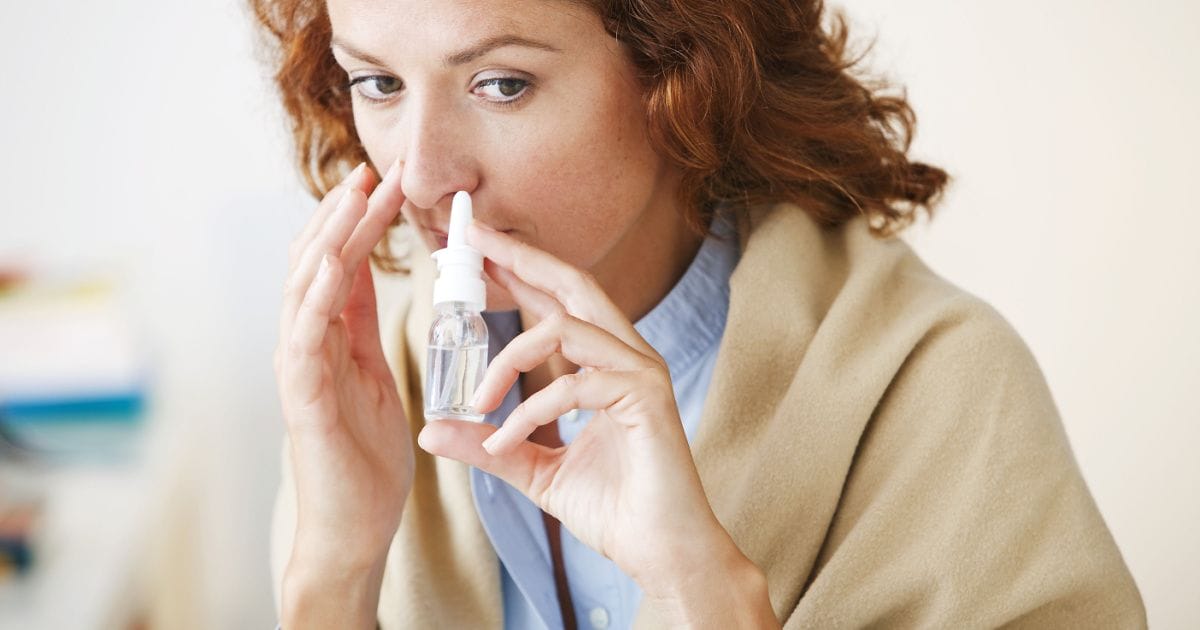Esketamine, also known in the United States by the brand name ‘Spravato’, is a drug related to the anesthetic and street drug ketamine. In the US, it was recently approved to treat depressive disorders in certain people, under clinical supervision, and in combination with antidepressants.

What is esketamine used for?
In 2019, the US Food and Drug Administration (FDA) approved the prescribing of esketamine nasal spray to adults with treatment-resistant depression (TRD). People with TRD have previously tried at least two different types of antidepressants for a period of at least six weeks per medication and have not experienced remission or seen at least a 50% improvement in their symptoms. [1]
This FDA approval is seen by some as premature and controversial because of concerns over side effects and dependency, as well as the long-term effects of using esketamine, of which little is currently known. Out of four trials, only one found esketamine use to be more effective in treating depression than a placebo. Some researchers are concerned that trials have not yet compared patients using esketamine combined with antidepressants with another drug combined with antidepressants, such as the antipsychotic olanzapine. [2]
How does esketamine work?
Esketamine is an NMDA receptor antagonist, meaning it blocks the activity of a particular type of neurotransmitter in the body, called N-Methyl-D-Aspartic Acid (NMDA). This produces an anaesthetic and analgesic effect (loss of sensation and pain relief).
In addition to some of the adverse effects mentioned later, esketamine can have a dissociative effect, meaning you experience yourself and the world around you a little differently. You might experience hallucinations, or you might perceive space and time differently, feeling like lots of time has passed or no time at all, compared to usual. Esketamine can make you feel as though you are separated from your body.
There are certain things that can make the experience more pleasant, such as being in a controlled and safe environment, sitting in a room with dim lighting, or listening to music. That’s one of the reasons esketamine is only administered under the supervision of a clinician, where healthcare professionals can support you until these effects pass. [3]
How is esketamine usually taken?
Esketamine, like ketamine, has the potential to distort your perception of reality within two hours of treatment, with many people experiencing visual or auditory hallucinations (seeing or hearing things that others can’t). Although it has been approved by the FDA, it is still only used among patients with treatment-resistant depression (TRD) and under strict clinical supervision.
If you’re prescribed esketamine for TRD in the US, you will receive a series of nasal sprays in a clinical setting as an outpatient. You will also continue to take your existing oral antidepressant treatment, the idea being that the esketamine provides quick relief of your depressive symptoms until the other medication takes effect. [1]
Esketamine can also be administered through your veins (intravenous), muscles (intramuscular), or under your skin (subcutaneous).
How long does esketamine stay in your system?
Aside from its antidepressant effects, esketamine produces several effects on the mind and the body. These usually subside completely within 90 minutes to two hours.
The effects of esketamine are short-lived, so it needs to be taken regularly. We do not yet know how long the effects last after stopping esketamine treatment, and every person will react in a slightly different way. Current evidence suggests taking esketamine for at least six months, with a review afterward depending on how you respond.
If you’re prescribed esketamine, you will be closely monitored by your doctor and the rest of the team within a clinical setting during treatment, and will likely be given a treatment plan after you finish your course of esketamine. [3]
Esketamine side effects
Side effects vary depending on your age and how the drug is administered. It is recommended that elderly people and people of Japanese origin are given half the dosage compared to younger adults, at least initially. Below are some of the common side effects associated with intranasal use (nose spray). Keep in mind that you may experience different side effects if you take esketamine parenterally (intra-muscular, intra-venous, subcutaneous). [4]
Specific side-effects with intranasal use – common:
- Anxiety
- Dizziness/vertigo
- Drowsiness
- Dry mouth
- Dysarthria
- Feeling abnormal/ abnormal sensations
- A change in body temperature
- Hallucinations, blurred vision,and altered perception
- Headache
- Hyperacusis (increased sensitivity to sound)
- Hyperhidrosis (increased/excessive sweating)
- Hypertension (elevated blood pressure)
- Altered mood
- Nasal complaints
- Nausea and vomiting
- Oral disorders
- Psychiatric disorders
- Tachycardia (heart rhythm disorder)
- Altered taste
- Tinnitus (ringing in ears)
- Tremor
- Urinary disorders
Specific side-effects with intranasal use – frequency not known:
- Cystitis [4]
Because esketamine can make you feel nauseous, people prescribed it for TRD in the US are advised not to eat within two hours of treatment, or drink within 30 minutes. Due to the potential to make you feel drowsy, you’ll also be asked to abstain from drinking alcohol for 24 hours on either side of treatment. [3]
Esketamine precautions
If you’re prescribed esketamine for depressive disorder, you need to tell your doctor if you have, or have ever had, any of the following:
- Bipolar disorder(current diagnosis or previous history)
- Cardiovascular conditions
- History of drug abuse
- Hypertension (elevated blood pressure)
- Mania (current diagnosis or previous history)
- Psychosis
- Raised intracranial pressure – pressure inside the skull, brain,and cerebrospinal fluid (CSF)
- Respiratory conditions (affecting your lungs and breathing)
- Thyroid dysfunction – over or underactive [4]
You are advised not to drive or operate heavy machinery until the day after taking esketamine, and having had a good night’s sleep. [3]
Dependency
Esketamine can potentially be addictive, especially in people who are or have ever been dependent on drugs or alcohol. That’s why before being prescribed esketamine, you will be asked if you have a history of drug and alcohol misuse. This is also why it is only provided in a clinic, under supervision, and dispensed in disposable devices containing only one dose.
If you’re prescribed esketamine, you will be monitored carefully for signs of addiction, and followed up throughout your treatment process. [3]
Esketamine interactions
Esketamine has interactions with over 200 types of drugs, including alcohol, cannabidiol, antidepressants such as venlafaxine, antipsychotics such as haloperidol and risperidone, antiepileptics such as pregabalin and benzodiazepines such as diazepam and lorazepam. Always speak to your doctor and read the label and patient information leaflet thoroughly before starting a new medication. [4]
Caffeine is known to have a strong interaction with ketamine, enhancing stimulant responses and risk of death. [5] Although little research is available on whether there is a similar relationship between esketamine and caffeine, given the proximity of the two drugs, it is worth speaking to your doctor about how much caffeine – if any – you can consume while taking esketamine.
What to do if you overdose on esketamine
Since esketamine is delivered in a clinical setting under the close supervision of medical professionals, an overdose is unlikely to occur. But if you have taken esketamine outside a clinical setting and are worried you’ve taken too much, seek urgent medical advice, for example by calling 911.
Esketamine alternatives
If you’re prescribed esketamine for TRD then it’s because you haven’t responded to at least two other different types of antidepressants. If you don’t find esketamine helpful in treating your TRD or if you are concerned about the side-effects or the potential longer-term effects, there are other options available.
You might consider these other FDA-approved treatments for TRD:
- A combination of the antipsychotic drug olanzapine along with a selective serotonin reuptake inhibitor (SSRI) such as fluoxetine. Speak to your doctor to see if this combination of psychiatric medications could be a viable treatment option for you.
- Electroconvulsive therapy (ECT) involves sending an electric current through your brain while you’re under anaesthesia. This causes a brief surge of electrical activity within your brain (a seizure) and can help improve symptoms of some mental health problems. [6]
- Transcranial magnetic stimulation (TMS) is a treatment where your brain is repeatedly stimulated using magnetic fields. It is approved by both the FDA in the US and NICE in the UK for people with severe depression who haven’t responded to other treatments. [7]
- Vagus nerve stimulation (VNS) is a type of surgery carried out under anaesthesiathat can treat people with TRD and epilepsy. Doctors place a small electric device, similar to a pacemaker, under the skin of your chest. This device is attached with some wires to the vagus nerve, which sends signals to your brain. The device sends electrical pulses to your vagus nerve for 30 seconds every 5 minutes. The battery life of a VNS device is between 3 to 8 years, but the device can be removed or switched off sooner if needed. [8]
- Esketamine for treatment-resistant depression. Johns Hopkins Medicine. Retrieved August 11, 2023, from https://www.hopkinsmedicine.org/health/treatment-tests-and-therapies/esketamine-for-treatment-resistant-depression
- Gastaldon, C., Papola, D., Ostuzzi, G., & Barbui, C. (2019). Esketamine for treatment resistant depression: a trick of smoke and mirrors? Epidemiology and Psychiatric Sciences, 29(e79). https://doi.org/10.1017/s2045796019000751
- Esketamine – patient information leaflet. Cumbria, Northumberland, Tyne and Wear NHS Foundation Trust. Retrieved August 14,2023 from https://www.cntw.nhs.uk/resource-library/esketamine-patient-information-leaflet/
- Esketamine. National Institute for Health and Care Excellence (NICE). Retrieved August 14, 2023, from nice.org.uk
- Hsu H et al. Behavioural and toxic interaction profile of ketamine in combination with caffeine. Basic & Clinical Pharmacology & Toxicology. 2009 May;104(5):379-83. doi: 10.1111/j.1742-7843.2009.00382.x. Retrieved August 14, 2023 from https://pubmed.ncbi.nlm.nih.gov/19413657/
- Electroconvulsive therapy. Mind. Retrieved August 14, 2023, from https://www.mind.org.uk/information-support/drugs-and-treatments/electroconvulsive-therapy-ect/
- Depression – treatments. Mind. Retrieved August 14, 2023, from https://www.mind.org.uk/information-support/types-of-mental-health-problems/depression/treatments/
- Vagus nerve stimulation (VNS). Mind. Retrieved August 14, 2023, from https://www.mind.org.uk/information-support/drugs-and-treatments/vagus-nerve-stimulation-vns/
The Clinical Affairs Team at MentalHealth.com is a dedicated group of medical professionals with diverse and extensive clinical experience. They actively contribute to the development of content, products, and services, and meticulously review all medical material before publication to ensure accuracy and alignment with current research and conversations in mental health. For more information, please visit the Editorial Policy.
MentalHealth.com is a health technology company guiding people towards self-understanding and connection. The platform provides reliable resources, accessible services, and nurturing communities. Its purpose is to educate, support, and empower people in their pursuit of well-being.
Claire Bennett is a medical writer with 14+ years of experience with a (B.Sc.) degree in Psychology from the University of Sheffield.
Morgan Blair is a licensed therapist, writer and medical reviewer, holding a master’s degree in clinical mental health counseling from Northwestern University.
Further Reading
The Clinical Affairs Team at MentalHealth.com is a dedicated group of medical professionals with diverse and extensive clinical experience. They actively contribute to the development of content, products, and services, and meticulously review all medical material before publication to ensure accuracy and alignment with current research and conversations in mental health. For more information, please visit the Editorial Policy.
MentalHealth.com is a health technology company guiding people towards self-understanding and connection. The platform provides reliable resources, accessible services, and nurturing communities. Its purpose is to educate, support, and empower people in their pursuit of well-being.

